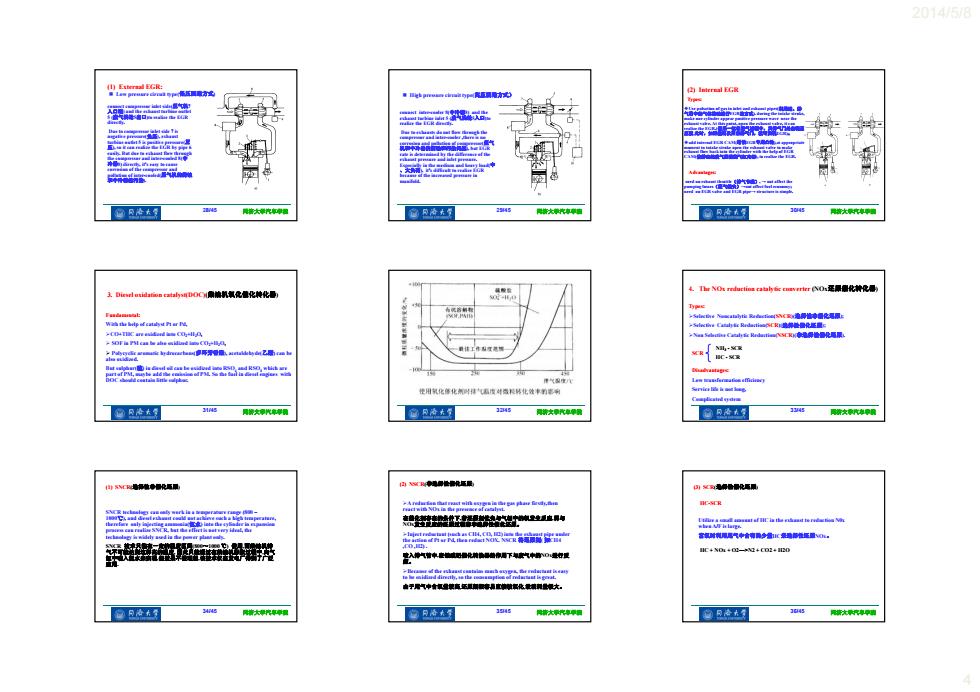正在加载图片...

201458 EaG我: 。行m金d方之 惠igh preoam由may动力 2 的R冷大复 窗凡冷法 大汽单 留凡冷复 大汽 王Bsd址@n catalysn DOC判原裤机氧代體化转化叠) 长T如NOs rrductins catalytc cuverierO是票轮e是 →+ah鱼长室造化根上 Wa山f catlys Par Pd >COTIC:ane adand am COallyA, 学3 aa Sdeie Canalyfc Redatian(sCK量重厚 产4DFia5制can be afe okd山ndaw0+线 { 使用帆化修化炳时律气惠度对雪耗时化效丰前家响 3145 包凡冷大 12345 145 鲜C雅R原 西w我能R压最 团到量果 BC-SCR 于整上 应n:代家 含时气中★南青少量C邮准压量NO, 0, 公营中下气信D和量 IC+NOL402-N24C024 1120 于骨气中使高压期服移宜钟敏氧化量璃奥业大, 包R冷法? 344 物P冷 1945 应R冷大2014/5/8 4 28/45 同济大学汽车学院 Low pressure circuit type(低压回路方式) connect compressor inlet side(压气机7 入口端) and the exhaust turbine outlet 5 (废气涡轮5出口)to realize the EGR directly. Due to compressor inlet side 7 is negative pressure(负压), exhaust turbine outlet 5 is positive pressure(正 压), so it can realize the EGR by pipe 6 easily. But due to exhaust flow through the compressor and inter-cooled 8(中 冷器8) directly, it's easy to cause corrosion of the compressor and pollution of inter-cooled(压气机的腐蚀 和中冷器的污染). (1) External EGR: 29/45 同济大学汽车学院 High pressure circuit type(高压回路方式) connect inter-cooler 8(中冷器8) and the exhaust turbine inlet 5 (废气涡轮5入口)to realize the EGR directly. Due to exhausts do not flow through the compressor and inter-cooler ,there is no corrosion and pollution of compressor(压气 机和中冷器的腐蚀和污染问题), but EGR rate is determined by the difference of the exhaust pressure and inlet pressure. Especially in the medium and heavy load(中 、大负荷), it’s difficult to realize EGR because of the increased pressure in manifold. 30/45 同济大学汽车学院 need no exhaust throttle(排气节流), → not affect the pumping losses(泵气损失)→not affect fuel economy; need no EGR valve and EGR pipe→ structure is simple. (2) Internal EGR add internal EGR CAM(增设EGR专用凸轮),at appropriate moment in intake stroke open the exhaust valve to make exhaust flow back into the cylinder with the help of EGR CAM(使排出的废气回流到气缸内部), to realize the EGR. Use pulsation of gas in inlet and exhaust pipes(利用进、排 气管中的气体脉动进行EGR的方式). during the intake stroke, make one cylinder appear positive pressure wave near the exhaust valve. At this point, open the exhaust valve, it can realize the EGR.(使某一缸在进气过程中,其排气门处出现正 压波,此时,如果能再次开启排气门,就可实现EGR)。 Advantages: Types: 31/45 同济大学汽车学院 3. Diesel oxidation catalyst(DOC)(柴油机氧化催化转化器) Fundamental: With the help of catalyst Pt or Pd, CO+THC are oxidized into CO2+H2O, SOF in PM can be also oxidized into CO2+H2O, Polycyclic aromatic hydrocarbons(多环芳香烃), acetaldehyde(乙醛) can be also oxidized. But sulphur(硫) in diesel oil can be oxidized into RSO4 and RSO3 which are part of PM, maybe add the emission of PM. So the fuel in diesel engines with DOC should contain little sulphur. 32/45 同济大学汽车学院 33/45 同济大学汽车学院 4. The NOx reduction catalytic converter (NOx还原催化转化器) Types: Selective Noncatalytic Reduction(SNCR)(选择性非催化还原); Selective Catalytic Reduction(SCR)(选择性催化还原); Non Selective Catalytic Reduction(NSCR)(非选择性催化还原). NH3 - SCR HC - SCR SCR Disadvantages: Low transformation efficiency Service life is not long, Complicated system 34/45 同济大学汽车学院 SNCR technology can only work in a temperature range (800 ~ 1000℃), and diesel exhaust could not achieve such a high temperature, therefore only injecting ammonia(氨水) into the cylinder in expansion process can realize SNCR, but the effect is not very ideal, the technology is widely used in the power plant only. SNCR 技术只能在一定的温度区间(800~1000 ℃) 使用,而柴油机排 气不可能达到这样高的温度, 因此只能通过在柴油机膨胀过程中,向气 缸中喷入氨水来实现,但效果不很理想,该技术仅在发电厂得到了广泛 应用. (1) SNCR(选择性非催化还原) 35/45 同济大学汽车学院 A reduction that react with oxygen in the gas phase firstly,then react with NOx in the presence of catalyst. 在催化剂存在的条件下,若还原剂优先与气相中的氧发生反应,再与 NOx发生反应的还原过程称非选择性催化还原。 Inject reductant (such as CH4, CO, H2) into the exhaust pipe under the action of Pt or Pd, then reduct NOX. NSCR 将还原剂( 如CH4 ,CO ,H2) . 喷入排气管中,在铂或钯催化转换器的作用下与废气中的NOx进行反 应。 Because of the exhaust contains much oxygen, the reductant is easy to be oxidized directly, so the consumption of reductant is great. 由于尾气中含氧量较高,还原剂很容易直接被氧化,故消耗量极大。 (2) NSCR(非选择性催化还原) 36/45 同济大学汽车学院 Utilize a small amount of HC in the exhaust to reduction N0x when A/F is large. 富氧时利用尾气中含有的少量HC来选择性还原NOx。 (3) SCR(选择性催化还原) HC-SCR HC + NOx + O2—>N2 + CO2 + H2O